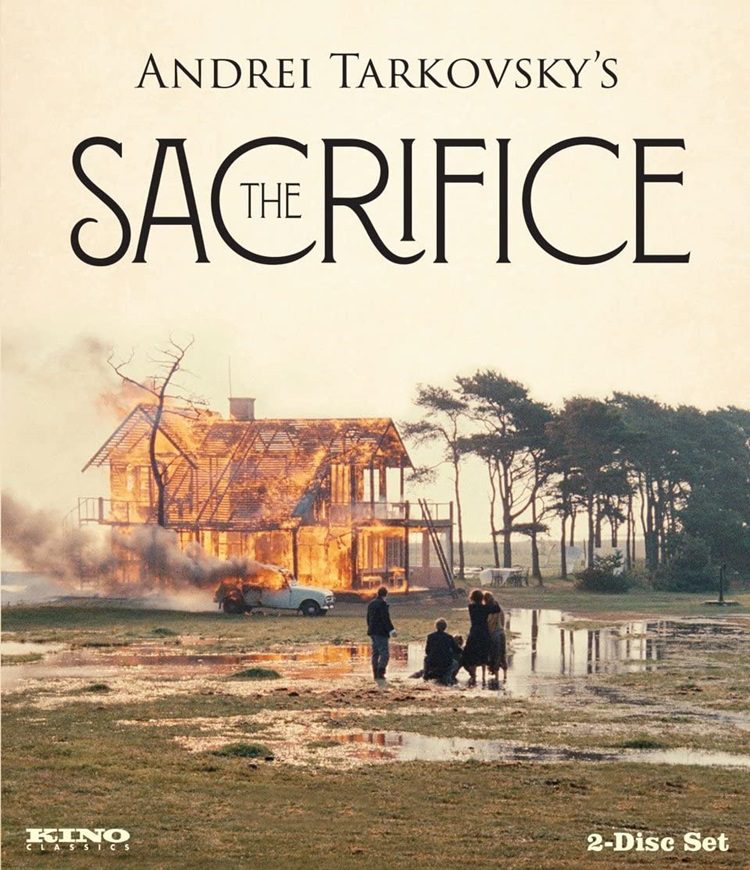
In literature classes, you learn that in short stories every paragraph, every sentence, every comma counts. Because of the short length, you cannot have any fluff. You have to weed out everything that isn’t important. Whereas in a novel you can sometimes let a sentence or two (or if you are Stephen King, entire chapters) slide. In a similar way with slow cinema – films that are more contemplative in nature and that utilize long shots with fewer cuts that normal cinema – one has to make each shot really count. Andrei Tarkovsky was a master of slow cinema.
Though The Sacrifice runs for 149 minutes, there are only 115 shots in the entire film. The first shot of the film lasts an incredible nine minutes and twenty-six seconds. He had intended it to be longer but that’s as long as one reel of film would take him at that time.
In that scene, Alexander (Erland Josephson), an academic, plants a Japanese tree with his young son – who is only called Little Man (Tommy Kjellqvist). After a time, a neighbor, Otto, (Allan Edwall) appears on his bike delighted that he’s been invited to Alexander’s birthday party later that day. The three then walk towards the house. Tarkovsky starts the scene with his camera far away from the characters. We see them in a distance and the camera tracks them as they slowly walk towards it. It is a movement that is almost imperceptible, going unnoticed until the characters are suddenly close, grown large on the screen.
There is very little action in that scene (and in the film as a whole) and the dialogue doesn’t seem very important; they speak of the tree and of birthdays and Alexander admits his relationship with God is “nonexistent”. But Tarkovsky asks us to contemplate it anyway. It is made slow on purpose. We are asked to study every little detail and are given the time to do so.
So much of the film is like this. The characters sit and talk, walk and talk, and move about the house and talk. They talk about silly things like how Otto collects stories of the paranormal, and important topics like the state of modern man. Tarkovsky poses his characters like paintings. Inside the house, I felt as if a Renoir had come to life. Because the scenes are long and the cuts few and far between, we come to ponder how beautifully composed it all is. We are forced to think about what the characters are saying and think things through.
About halfway through, we hear low-flying jet plans fly over head. They rattle the walls and knock a pitcher of milk over. After Alexander puts Little Man to bed, we can hear the television. A news program is on and the breaking news story is about the beginning of World War III and the pending nuclear holocaust. In any other film, this would be up close and center. We’d see shots of planes flying and tanks on the ground. Here, it is background noise. We watch Alexander walk towards the others; we see the TV in the distance, distorted. The power goes off before we learn much of anything.
The film isn’t interested in the actions of the war, but how the news effects its characters. Alexander cries out to God, proclaiming that he will give up everything he has, his material possessions and even his family, if God will reverse time and take this horror from the world. His wife breaks into hysterics.
Towards the end of the film, a house burns to the ground (normally, I’d consider this to be a spoiler, but in this case, that scene is literally on the cover of the Blu-ray). Tarkovsky shows the fire start then, in another long take, moves his camera away, getting the reaction of the characters and only when the house is nearly burnt to the ground, does he return to the action. In the documentary Directing Andrei Tarkovsky (included in this set), we learn that he only used one camera for this scene so when it jammed none of the footage was usable. They had to quickly build an entire new house just to burn it down again.
In 1979, Tarkovsky left his Russian homeland and never returned. He shot The Sacrifice in his hero Ingmar Berman’s homeland of Sweden. Most of the actors had been in numerous Bergman films. He used Sven Nykvist, Bergman’s cinematographer, to shoot it. As such, it feels very much like a Bergman movie. Yet it remains distinctly Tarkovsky as well.
It is, in some ways, a difficult film. It is not an exciting movie, yet it demands your attention. It is incredibly slow and yet beautiful. If you will allow yourself to accept what it is doing, it offers many rewards.
Kino Lorber’s new transfer is stunning. It is a remarkably beautiful film to begin with and what they’ve done with it is incredible. Tarkovsky knows how to stage a scene and so much of this film looks like a painting from a great master. This is a transfer you’ll want to show off.
Audio is quite good as well. It is a quiet film; one that enjoys silence more than noise. But the dialogue is always clear and the ambient noise comes in clean. Extras include an informative audio commentary by the translator Tarkovsky used on the set of The Sacrifice (which adds an interesting extra-textural layer to the film since Tarkovsky didn’t speak Swedish and most of his actors didn’t know Russian). There is also an interview with editor Michal Leszezylowki who also directed Directing Andrei Tarkovsky, which is a fascinating look into the making of the film and includes a wealth of behind-the-scenes footage. The booklet includes an essay and excerpts from Tarkovsky’s diaries.
The Sacrifice is a difficult film but one that is incredibly rewarding. Kino Lorber has provided an excellent transfer with some very compelling extras.